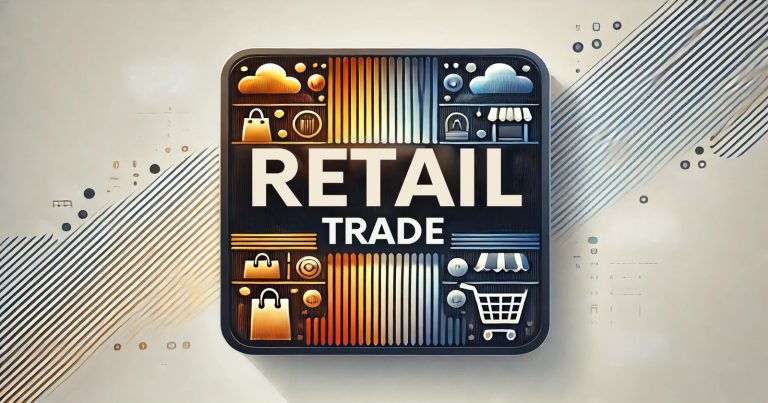Retail trade is the selling of goods or services to a consumer for direct use. Companies have used several avenues for retailing their products, such as stores, online media, and mobile services. Retail trade examples include grocery stores, clothing boutiques, and even Amazon, an online marketplace. It is the final interface of the supply chain, delivering the product directly to the end-users. The retail trade connects the manufacturers and wholesalers to the consumer. In this way, the products conveniently reach the customers, satisfying their specific needs and preferences. Retail trade examples include convenience stores like 7-Eleven, large departmental chains like Walmart, and e-commerce platforms like Flipkart. Apart from diverse products with personal services, the retail trade provides various purchasing channels, thereby significantly increasing customer satisfaction and fueling economic growth. This article covers the functions, types, and very clear examples relating to retail trade in everyday life.
What is Retail Trade?
Retailing refers to selling a small quantity of either goods or services to the final consumer. This sector is defined by including intermediaries between manufacturers/wholesalers and single buyer customers, although it consists of both offline shops and rapidly growing websites.
Retail trade is an important component of the economy. Retail trade caters to the needs and wants of consumers on a day-to-day basis by selling commodities in smaller, handy units. As compared with wholesalers, retailers sell in small units directly to the ultimate consumer. Retailers provide convenience, variety, and consumer-friendly services so that buying can be done conveniently.
Features of Retail Trade
Retail trade focuses on selling goods or services directly to final consumers in small quantities. It bridges the gap between manufacturers and end-users, ensuring convenience and accessibility. The features of retail trade highlight its customer-centric approach, small-scale operations, and diverse product offerings.
- Small Units: Retailers sell commodities to consumers in small units.
- Direct Contact: The retailers communicate with the customers face-to-face to know what customers need.
- Variety of Products: The retailers stock various products to meet the varied tastes of the consumers.
- Customer Focus: The retailers focus on customer satisfaction and service.
Types of Retail Trade
According to the nature of the business and the needs of the consumer, the nature of retail trade evolves. Retailing is one of the significantly diverse formats, including physical stores on one end and online space on the other. Each performs a specific task and provides services and products according to the circumstances of individual consumer behavior. The major types of retail trade include
Store-Based Retailing
Store-based retailing refers to the sale of goods or services through physical outlets where customers can browse and purchase in person. This format includes department stores, supermarkets, specialty shops, and convenience stores, catering to diverse consumer needs.
- Department Stores: Here there is a vast variety of products, including clothing, home goods, and electronics.Example: Macy’s and Target.
- Supermarkets: These outlets solely deal with the sale of food and household items.Example: Walmart and Kroger.
- Specialty Stores: Here there is a specific category, such as apparel or electronics.Example: Nike stores and Apple stores.
- Convenience Stores: These outlets sell daily need goods and come up around residential areas.Example: 7-Eleven.
Non-Store Retailing
Non-store retailing involves selling goods or services outside traditional physical stores, offering convenience and flexibility to consumers. This format includes e-commerce platforms, direct selling, telemarketing, and vending machines, catering to modern shopping preferences.
- E-Commerce: Customers can shop from any place.Example: Amazon, Flipkart.
- Telemarketing: Sales over the telephone.
- Direct Selling: The products are sold directly to the customers. They are often demonstrated. Example: Avon, Tupperware.
Retail Trade Examples with Real-Life Retail Outlets
Daily examples of retail trade are present and show the vast variety and scale of this business. Retailers provide goods at convenient points to suit different consumer demands. This is done through small shops, large departmental stores, or online services. These examples describe how retail trade brings manufacturers directly in contact with consumers. Easy-to-access outlets and personal touches offered by retail points help build confidence and loyalty. Some of the examples of retail trading outlets, which are illustrated below, help to show the scope of the sector.
Grocery Stores
Grocery stores cater to the sale of food and household essentials to daily consumers. There are local markets such as Trader Joe’s or Spar, offering a limited variety of fresh produce, snacks, and packaged goods. These stores usually have an organic and specialty section, appealing to health-conscious buyers. Other stores merge internet-based orders with in-home delivery for easier access to the consumers. Some grocery stores can be considered as the lifeblood of the neighborhood so long as its staples are in stock at all times.
Fashion Apparel Shops
Clothing boutiques like Zara and H&M deal with fashionable, affordable clothing for various target groups. They offer different clothing, including casual, formal, and seasonal collections. Boutiques tend to update their stock from time to time so that they have the latest trends and demands from customers. Personalized assistance and a stylish atmosphere make the experience enjoyable, thus encouraging loyalty among customers. Many boutiques also have online platforms through which their collections can be accessed by anyone in the world.
Online Marketplaces
Online marketplaces such as Amazon and Flipkart are changing the way one shops. The diversity of products is vast across categories. Consumers can shop from anywhere and at any time, thanks to the convenience offered by these platforms. It allows them to compare prices, read reviews, and get discounts, thus making online shopping both cost-effective and reliable. Advanced algorithms offer personalized recommendations that make the overall shopping experience even better. Logistics and delivery networks ensure timely and efficient orders to customers.
Pharmacies
Pharmacies like Walgreens cater to health needs through drugs, supplements, and medical equipment. The pharmacies offer prescription and over-the-counter drugs so that all the healthcare products are available. Pharmacies have nowadays provided other services, including health consultations, vaccinations, and chronic disease management. The customers are attended to by informed pharmacists who give advice and recommendations to their needs. Pharmacies are also crucial during emergencies since they provide life-saving medications in adequate supply.
Convenience Stores
Convenience stores like 7-Eleven and Circle K cater to consumers who need quick access to everyday essentials. These stores operate extended hours and are strategically located near residential or high-traffic areas. They stock items like snacks, beverages, toiletries, and other miscellaneous goods, meeting immediate consumer needs. Some convenience stores also offer fuel, e-banking services like ATMs, and ready-to-eat meals, further increasing their utility. Their compact size and wide product range make them a preferred choice for quick, hassle-free shopping.
Benefits of Retail Trade Examples
Retail trade benefits consumers and the economy by making products easily accessible and enhancing the shopping experience. Retailers offer tailored services and diverse options that cater to specific customer preferences. Below are expanded benefits of retail trade examples:
Convenience
Retailers reduce the time taken to shop by placing products closer to consumers. For instance, neighborhood grocery stores reduce the time and cost of transportation for customers. Retail outlets also offer services such as home delivery and online shopping, making access even easier. Quick checkout processes and multiple payment options make shopping easier. Retail trade ensures that goods are always accessible and meet immediate needs.
Diversity
Retailers offer a wide range of different products all at one stop, where customers can browse through many options. Hence the diversification would satisfy the differences, and budgets of their customers. Large departmental stores have apparel, electronics, and groceries, thus converging all these under one shopping venue. Adding local and international brands satisfies the majority of consumers. There is healthy competition between retailers by diversifying their portfolios, which leads to good deals on products for the consumer.
Service-Oriented
Retailers emphasize the personalization of the shopping experience through services tailored to a customer’s preference. The workers assist customers in choosing the right products based on professional consultancy and recommendations. Some outlets offer loyalty programs, discounts, and promotions for habitual customers. Several retail stores also provide add-on services such as comfortable seating arrangements, free product samples, or trial rooms to attract a larger customer base. A service approach ensures that long-term customer relationships are created, thereby ensuring repeated business.
Accessibility
Retail trade ensures that goods are readily available in urban and rural settings. Convenience stores and internet portals break the geographical boundaries to reach even remote areas. Retailers adopt local languages and cultural practices to communicate better with customers. They also offer access to disabled customers by arranging stores and special services to be more accessible. Accessibility brings inclusivity, where all consumers can fulfill their requirements with ease.
Economic Development
It further develops the economy through employment creation and support for small businesses. These retail shops hire people to work in the various outlets, such as selling and warehousing and customers. Small-time retailers also sustain the local economies by buying some of their products from close small-scale suppliers. Retail trade enhances entrepreneurship since it creates an enabling environment for start-ups. Through this sector, consumer spending gets stimulated, enhancing GDP and making the economy relatively stable.
Retail Trade FAQs
What is retail trade?
Retail trade involves selling commodities or services to ultimate consumers in small quantities. The wholesaler finds the retailer an intermediary between them and the buyer so that the buyer can gain access easily.
Give some examples of retail trading outlets.
Grocery stores such as Walmart, clothing stores like H&M, and internet platforms like Amazon. Pharmacies and convenience stores also fall within the category of retail trade.
What is the difference between retail and wholesale trade?
Retail trade is selling in smaller quantities to the consumer directly, while wholesale trade is the selling of large quantities to businesses or retailers. Retailers deal with the end-users, while wholesalers deal with the intermediaries.
What are the advantages of retail trade?
The advantages of retail trade to consumers are easy accessibility to goods, a wide range of products, and customer-oriented services such as personalized assistance.
Give an example of wholesale and retail trade.
Wholesale trade entails doing a 500-unit volume transaction, perhaps to the distributor, whereas a retailer sells on the retail line one unit to each individual customer. It, therefore goes further to add that retail trade is essential in most economies and in real life.


